2019 TOYOTA SUPRA ESP
[x] Cancel search: ESPPage 259 of 456
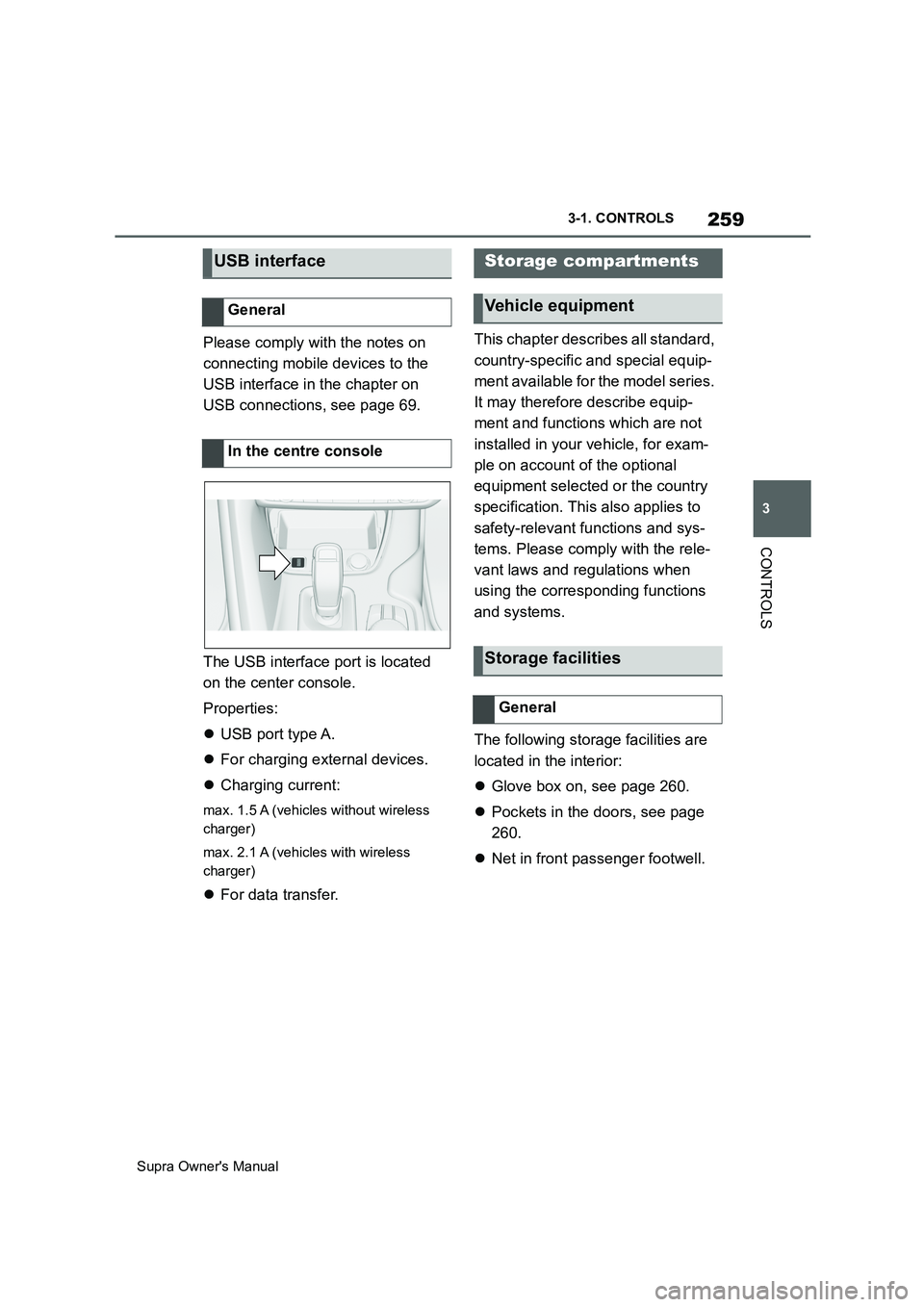
259
3
Supra Owner's Manual3-1. CONTROLS
CONTROLS
Please comply with the notes on
connecting mobile devices to the
USB interface in the chapter on
USB connections, see page 69.
The USB interface port is located
on the center console.
Properties:
USB port type A.
For charging external devices.
Charging current:
max. 1.5 A (vehicles without wireless
charger)
max. 2.1 A (vehicles with wireless
charger)
For data transfer.This chapter describes all standard,
country-specific and special equip-
ment available for the model series.
It may therefore describe equip-
ment and functions which are not
installed in your vehicle, for exam-
ple on account of the optional
equipment selected or the country
specification. This also applies to
safety-relevant functions and sys-
tems. Please comply with the rele-
vant laws and regulations when
using the corresponding functions
and systems.
The following storage facilities are
located in the interior:
Glove box on, see page 260.
Pockets in the doors, see page
260.
Net in front passenger footwell.
USB interface
General
In the centre console
Storage compartments
Vehicle equipment
Storage facilities
General
Page 261 of 456

261
3
Supra Owner's Manual3-1. CONTROLS
CONTROLS
This chapter describes all standard,
country-specific and special equip-
ment available for the model series.
It may therefore describe equip-
ment and functions which are not
installed in your vehicle, for exam-
ple on account of the optional
equipment selected or the country
specification. This also applies to
safety-relevant functions and sys-
tems. Please comply with the rele-
vant laws and regulations when
using the corresponding functions
and systems. Safety note
WARNING
Fragile objects, for example glass
bottles or glasses, can break in the
event of an accident. Shards may
scatter throughout the interior. There
is a danger of injury or damage to
property. Do not use any fragile
objects while driving. Only stow fragile
objects in closed storage compart-
ments.
Cupholder
Safety note
WARNING
Unsuitable containers placed in the
cupholders may damage the cuphold-
ers or be flung into the interior, for
example in the event of an accident or
during braking or evasive manoeu-
vres. Spilt liquids can distract the
driver from the road and lead to an
accident. Hot beverages may damage
the cupholders or cause scalding.
There is a danger of injury or damage
to property. Do not force objects into
the cupholder. Use lightweight, seala-
ble containers that are shatterproof.
Do not transport hot drinks.
Boot
Vehicle equipment
Loads
Safety notes
WARNING
A high gross vehicle weight can make
the tyres to overheat, causing internal
damage and a sudden loss of tyre
inflation pressure. Handling charac-
teristics can be negatively influenced,
for example reduced directional sta-
bility, longer braking distance and
modified steering characteristics.
There is a danger of accidents.
Please comply with the permitted load
index of the tyre, and do not exceed
the permitted gross vehicle weight.
Page 266 of 456
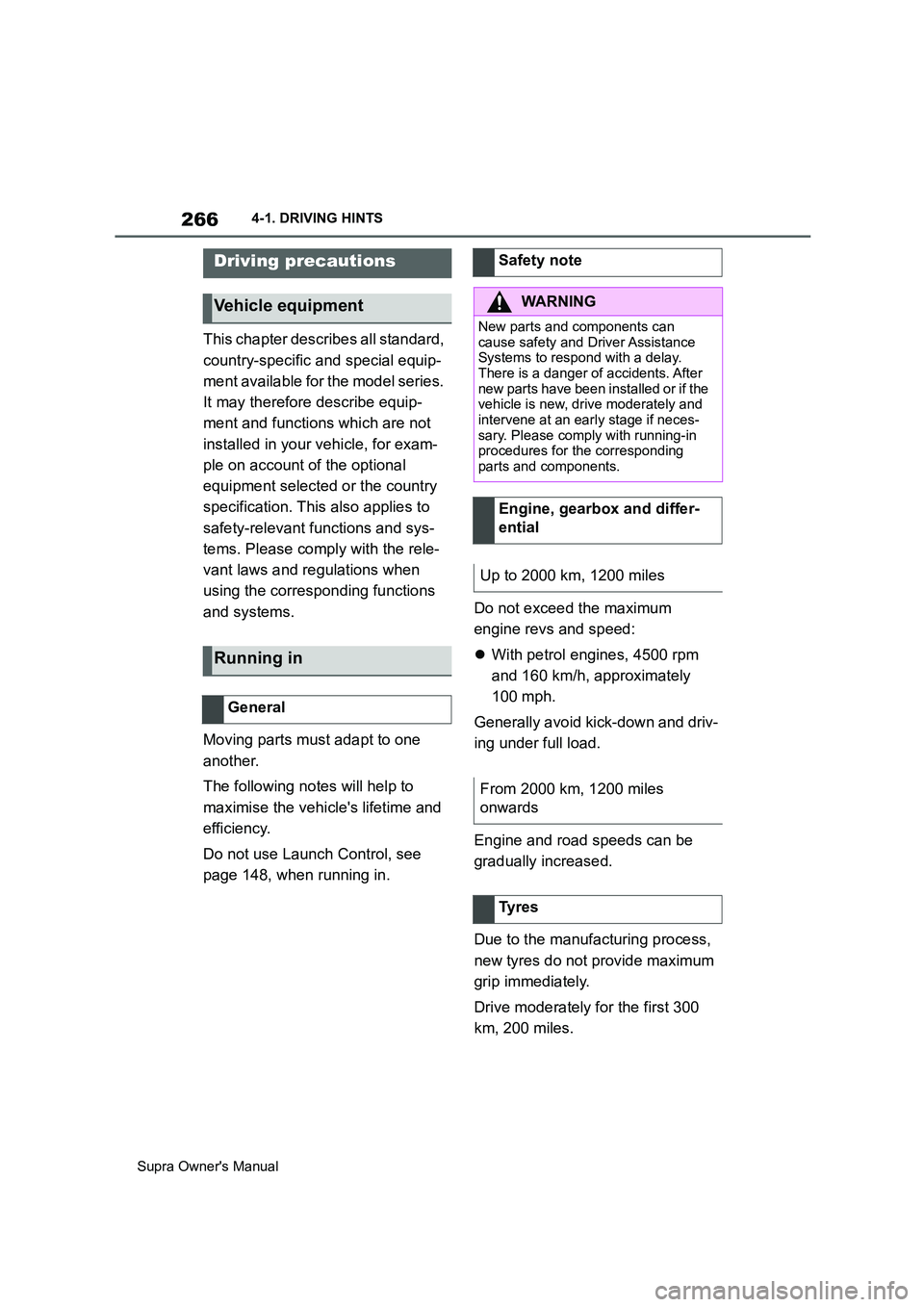
266
Supra Owner's Manual4-1. DRIVING HINTS
4-1.DRIV ING HINTS
This chapter describes all standard,
country-specific and special equip-
ment available for the model series.
It may therefore describe equip-
ment and functions which are not
installed in your vehicle, for exam-
ple on account of the optional
equipment selected or the country
specification. This also applies to
safety-relevant functions and sys-
tems. Please comply with the rele-
vant laws and regulations when
using the corresponding functions
and systems.
Moving parts must adapt to one
another.
The following notes will help to
maximise the vehicle's lifetime and
efficiency.
Do not use Launch Control, see
page 148, when running in.Do not exceed the maximum
engine revs and speed:
With petrol engines, 4500 rpm
and 160 km/h, approximately
100 mph.
Generally avoid kick-down and driv-
ing under full load.
Engine and road speeds can be
gradually increased.
Due to the manufacturing process,
new tyres do not provide maximum
grip immediately.
Drive moderately for the first 300
km, 200 miles.
Driving precautions
Vehicle equipment
Running in
General
Safety note
WARNING
New parts and components can
cause safety and Driver Assistance
Systems to respond with a delay.
There is a danger of accidents. After
new parts have been installed or if the
vehicle is new, drive moderately and
intervene at an early stage if neces-
sary. Please comply with running-in
procedures for the corresponding
parts and components.
Engine, gearbox and differ-
ential
Up to 2000 km, 1200 miles
From 2000 km, 1200 miles
onwards
Ty r e s
Page 269 of 456
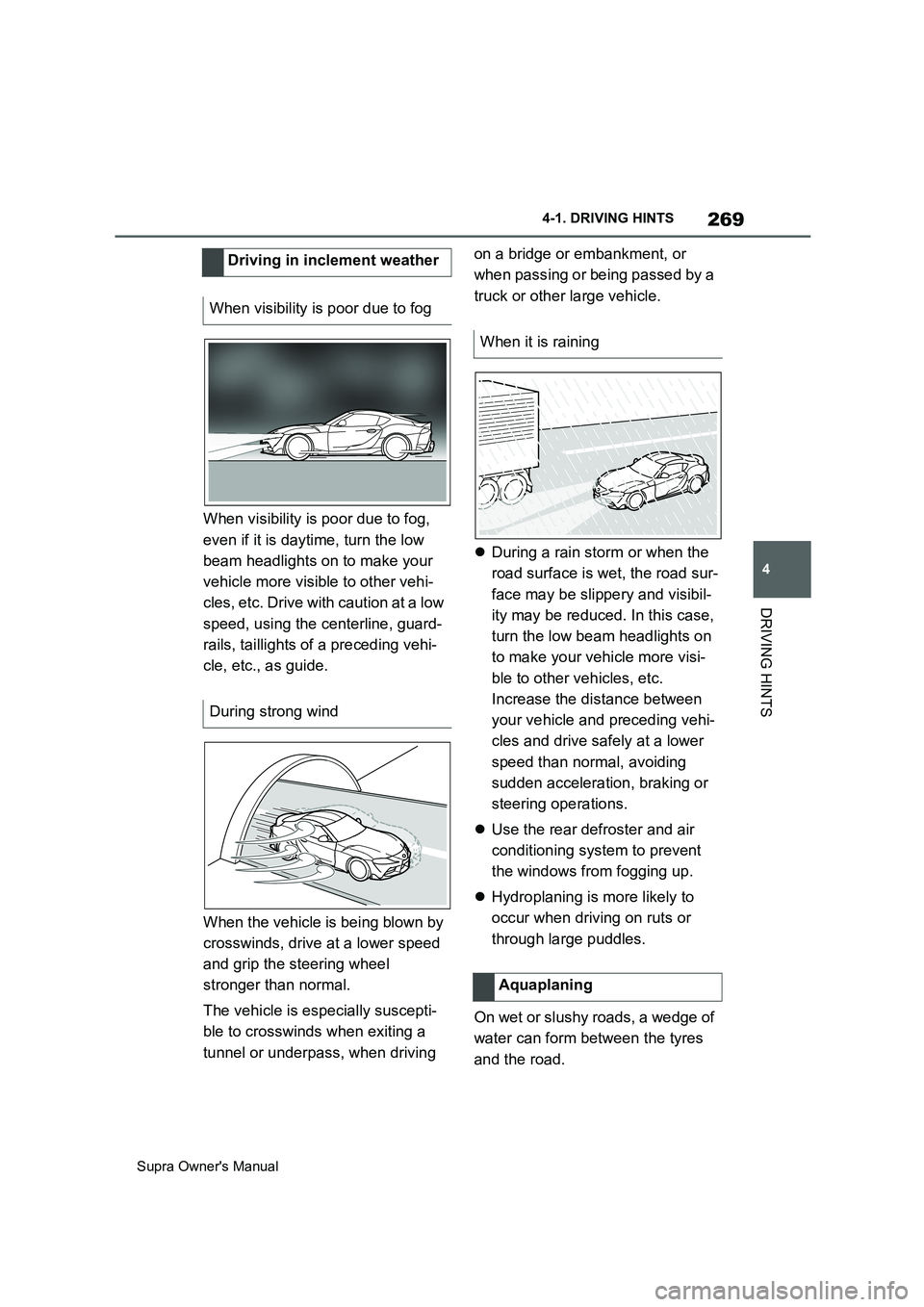
269
4
Supra Owner's Manual4-1. DRIVING HINTS
DRIVING HINTS
When visibility is poor due to fog,
even if it is daytime, turn the low
beam headlights on to make your
vehicle more visible to other vehi-
cles, etc. Drive with caution at a low
speed, using the centerline, guard-
rails, taillights of a preceding vehi-
cle, etc., as guide.
When the vehicle is being blown by
crosswinds, drive at a lower speed
and grip the steering wheel
stronger than normal.
The vehicle is especially suscepti-
ble to crosswinds when exiting a
tunnel or underpass, when driving on a bridge or embankment, or
when passing or being passed by a
truck or other large vehicle.
During a rain storm or when the
road surface is wet, the road sur-
face may be slippery and visibil-
ity may be reduced. In this case,
turn the low beam headlights on
to make your vehicle more visi-
ble to other vehicles, etc.
Increase the distance between
your vehicle and preceding vehi-
cles and drive safely at a lower
speed than normal, avoiding
sudden acceleration, braking or
steering operations.
Use the rear defroster and air
conditioning system to prevent
the windows from fogging up.
Hydroplaning is more likely to
occur when driving on ruts or
through large puddles.
On wet or slushy roads, a wedge of
water can form between the tyres
and the road. Driving in inclement weather
When visibility is poor due to fog
During strong wind
When it is raining
Aquaplaning
Page 271 of 456
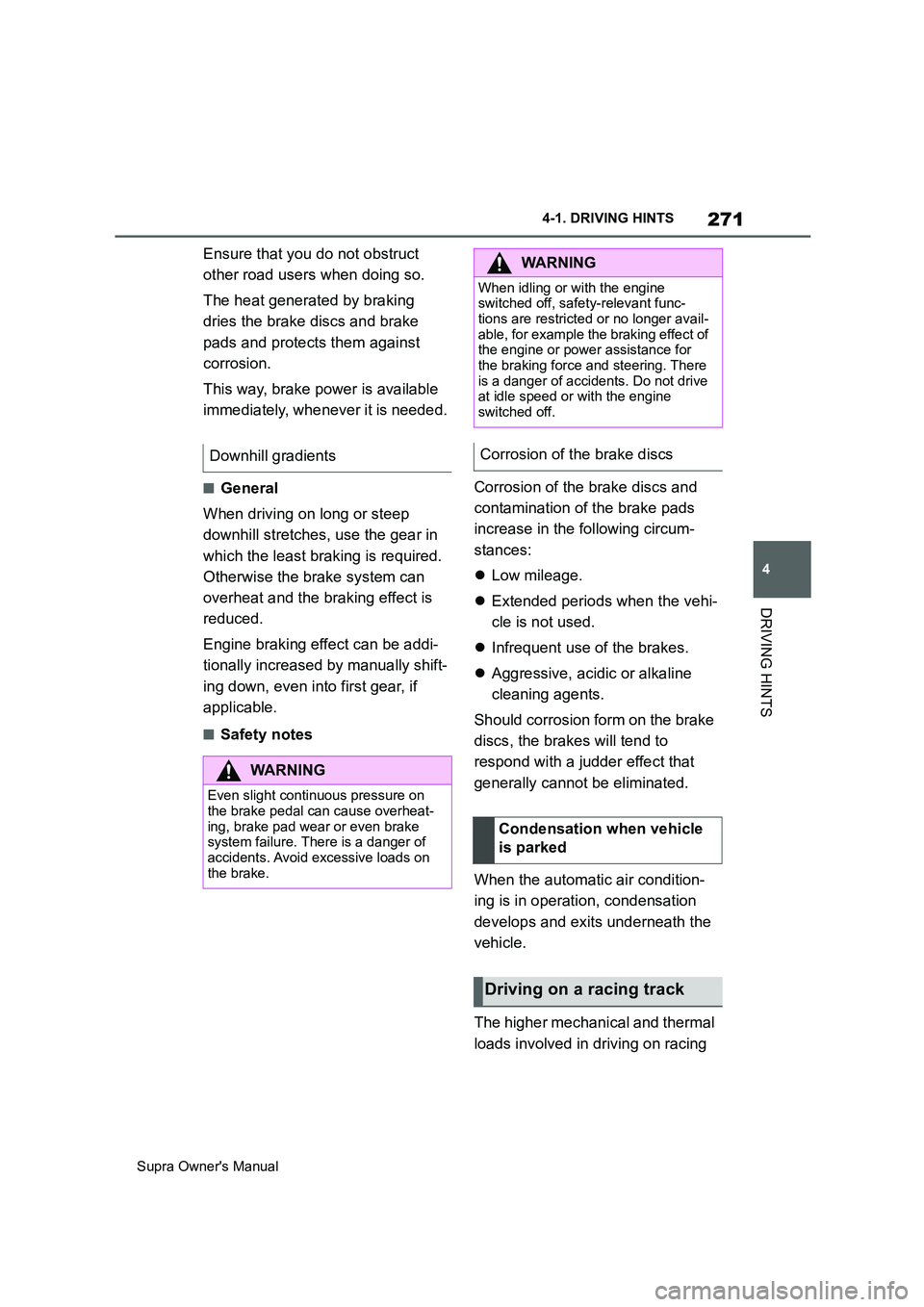
271
4
Supra Owner's Manual4-1. DRIVING HINTS
DRIVING HINTS
Ensure that you do not obstruct
other road users when doing so.
The heat generated by braking
dries the brake discs and brake
pads and protects them against
corrosion.
This way, brake power is available
immediately, whenever it is needed.
■General
When driving on long or steep
downhill stretches, use the gear in
which the least braking is required.
Otherwise the brake system can
overheat and the braking effect is
reduced.
Engine braking effect can be addi-
tionally increased by manually shift-
ing down, even into first gear, if
applicable.
■Safety notesCorrosion of the brake discs and
contamination of the brake pads
increase in the following circum-
stances:
Low mileage.
Extended periods when the vehi-
cle is not used.
Infrequent use of the brakes.
Aggressive, acidic or alkaline
cleaning agents.
Should corrosion form on the brake
discs, the brakes will tend to
respond with a judder effect that
generally cannot be eliminated.
When the automatic air condition-
ing is in operation, condensation
develops and exits underneath the
vehicle.
The higher mechanical and thermal
loads involved in driving on racing Downhill gradients
WARNING
Even slight continuous pressure on
the brake pedal can cause overheat-
ing, brake pad wear or even brake
system failure. There is a danger of
accidents. Avoid excessive loads on
the brake.
WARNING
When idling or with the engine
switched off, safety-relevant func-
tions are restricted or no longer avail-
able, for example the braking effect of
the engine or power assistance for
the braking force and steering. There
is a danger of accidents. Do not drive
at idle speed or with the engine
switched off.
Corrosion of the brake discs
Condensation when vehicle
is parked
Driving on a racing track
Page 272 of 456
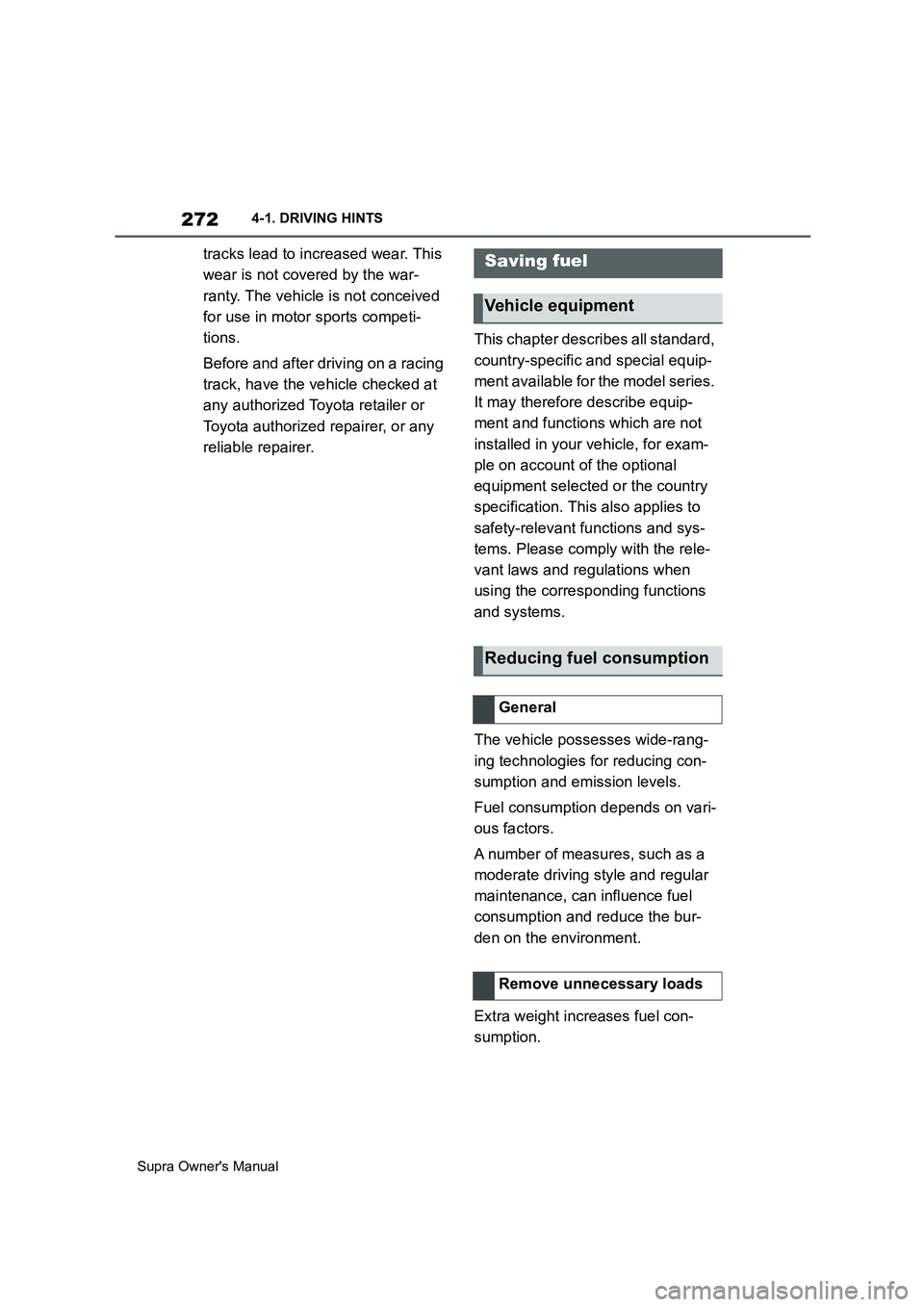
272
Supra Owner's Manual4-1. DRIVING HINTS
tracks lead to increased wear. This
wear is not covered by the war-
ranty. The vehicle is not conceived
for use in motor sports competi-
tions.
Before and after driving on a racing
track, have the vehicle checked at
any authorized Toyota retailer or
Toyota authorized repairer, or any
reliable repairer.This chapter describes all standard,
country-specific and special equip-
ment available for the model series.
It may therefore describe equip-
ment and functions which are not
installed in your vehicle, for exam-
ple on account of the optional
equipment selected or the country
specification. This also applies to
safety-relevant functions and sys-
tems. Please comply with the rele-
vant laws and regulations when
using the corresponding functions
and systems.
The vehicle possesses wide-rang-
ing technologies for reducing con-
sumption and emission levels.
Fuel consumption depends on vari-
ous factors.
A number of measures, such as a
moderate driving style and regular
maintenance, can influence fuel
consumption and reduce the bur-
den on the environment.
Extra weight increases fuel con-
sumption.Saving fuel
Vehicle equipment
Reducing fuel consumption
General
Remove unnecessary loads
Page 274 of 456
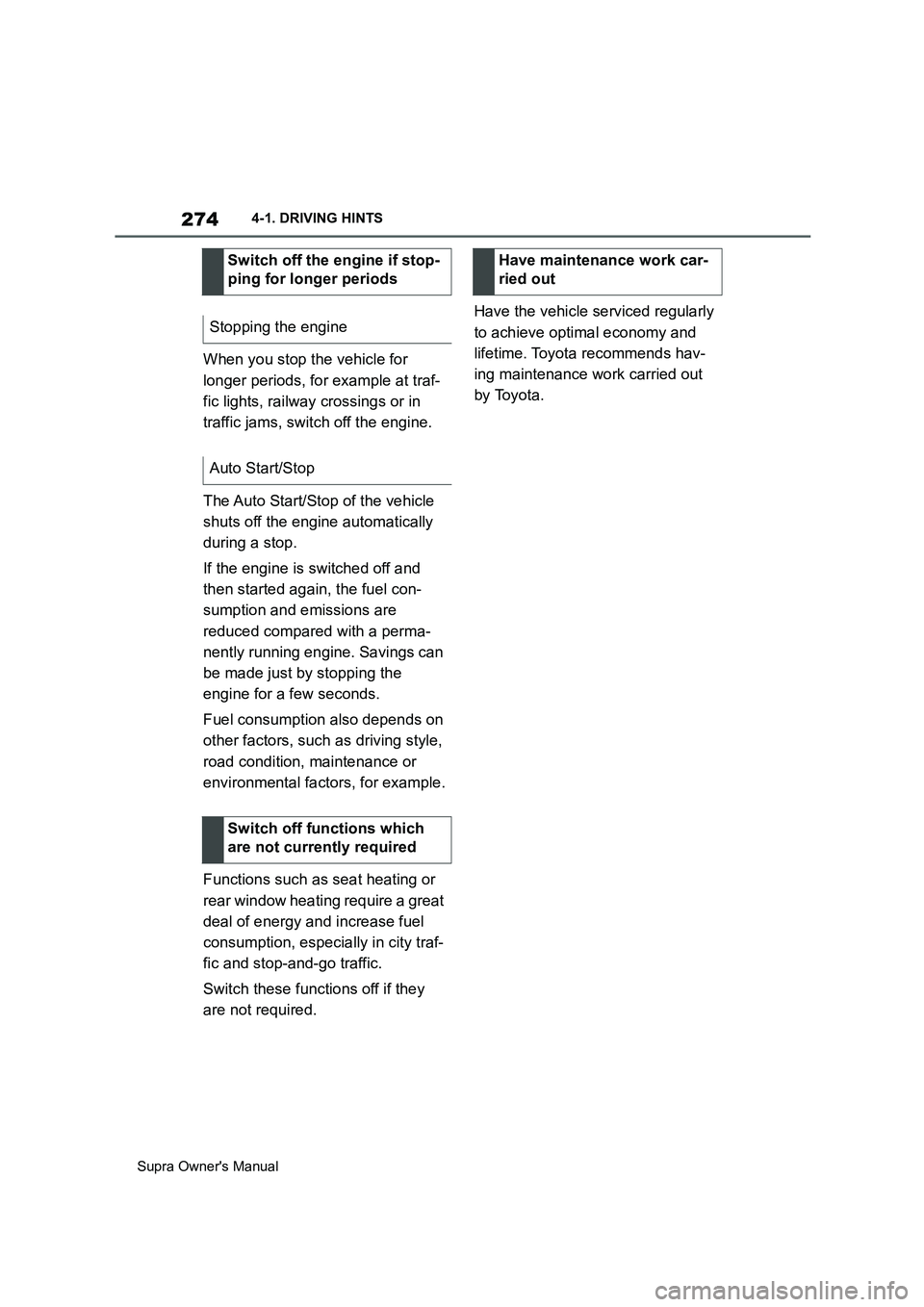
274
Supra Owner's Manual4-1. DRIVING HINTS
When you stop the vehicle for
longer periods, for example at traf-
fic lights, railway crossings or in
traffic jams, switch off the engine.
The Auto Start/Stop of the vehicle
shuts off the engine automatically
during a stop.
If the engine is switched off and
then started again, the fuel con-
sumption and emissions are
reduced compared with a perma-
nently running engine. Savings can
be made just by stopping the
engine for a few seconds.
Fuel consumption also depends on
other factors, such as driving style,
road condition, maintenance or
environmental factors, for example.
Functions such as seat heating or
rear window heating require a great
deal of energy and increase fuel
consumption, especially in city traf-
fic and stop-and-go traffic.
Switch these functions off if they
are not required.Have the vehicle serviced regularly
to achieve optimal economy and
lifetime. Toyota recommends hav-
ing maintenance work carried out
by Toyota. Switch off the engine if stop-
ping for longer periods
Stopping the engine
Auto Start/Stop
Switch off functions which
are not currently required
Have maintenance work car-
ried out
Page 276 of 456
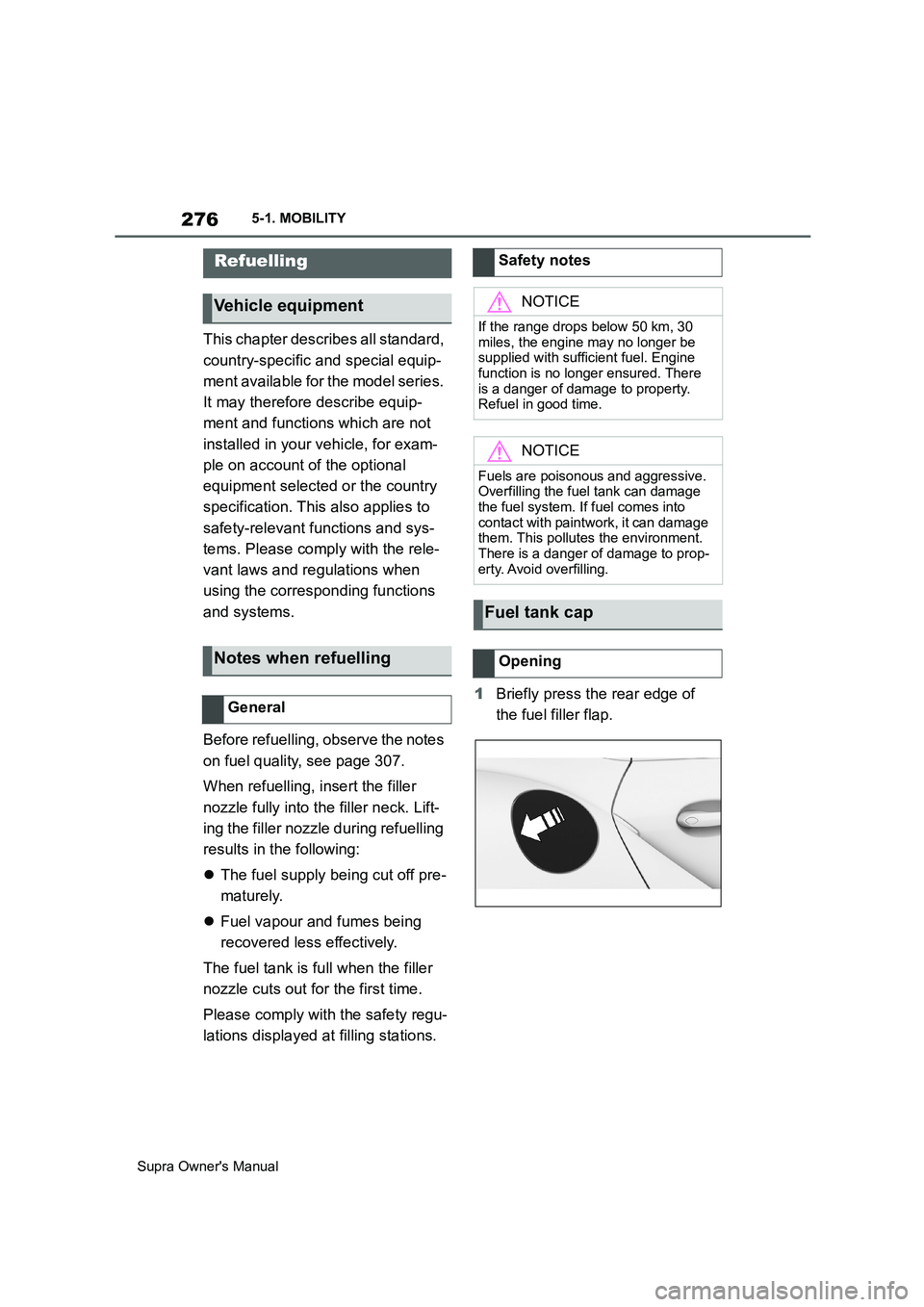
276
Supra Owner's Manual5-1. MOBILITY
5-1.MOBILITY
This chapter describes all standard,
country-specific and special equip-
ment available for the model series.
It may therefore describe equip-
ment and functions which are not
installed in your vehicle, for exam-
ple on account of the optional
equipment selected or the country
specification. This also applies to
safety-relevant functions and sys-
tems. Please comply with the rele-
vant laws and regulations when
using the corresponding functions
and systems.
Before refuelling, observe the notes
on fuel quality, see page 307.
When refuelling, insert the filler
nozzle fully into the filler neck. Lift-
ing the filler nozzle during refuelling
results in the following:
The fuel supply being cut off pre-
maturely.
Fuel vapour and fumes being
recovered less effectively.
The fuel tank is full when the filler
nozzle cuts out for the first time.
Please comply with the safety regu-
lations displayed at filling stations.1Briefly press the rear edge of
the fuel filler flap.
Refuelling
Vehicle equipment
Notes when refuelling
General
Safety notes
NOTICE
If the range drops below 50 km, 30
miles, the engine may no longer be
supplied with sufficient fuel. Engine
function is no longer ensured. There
is a danger of damage to property.
Refuel in good time.
NOTICE
Fuels are poisonous and aggressive.
Overfilling the fuel tank can damage
the fuel system. If fuel comes into
contact with paintwork, it can damage
them. This pollutes the environment.
There is a danger of damage to prop-
erty. Avoid overfilling.
Fuel tank cap
Opening